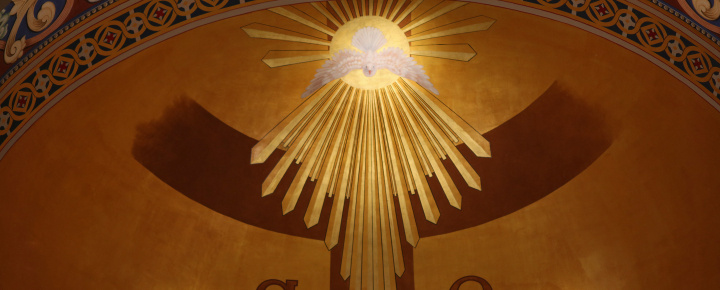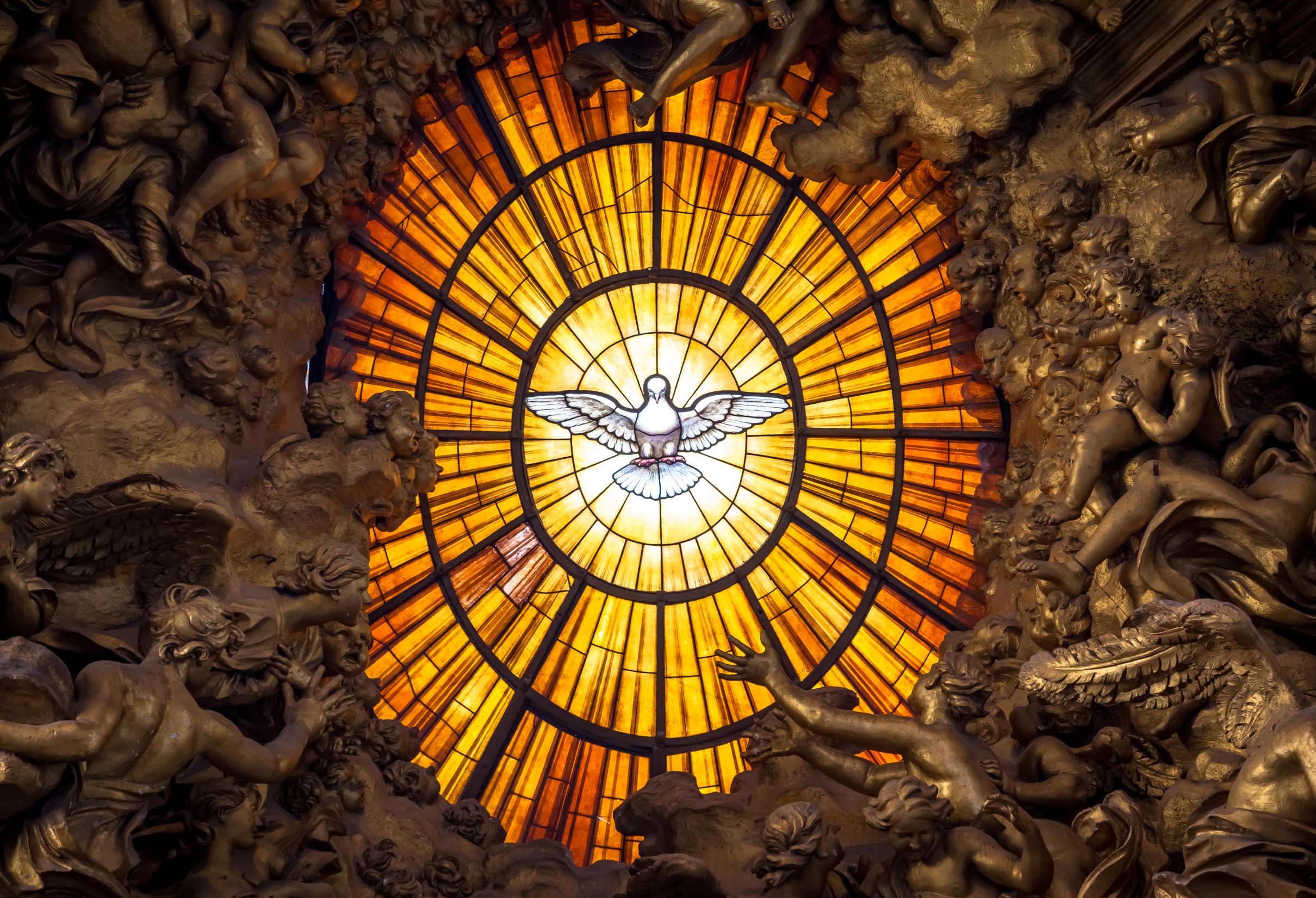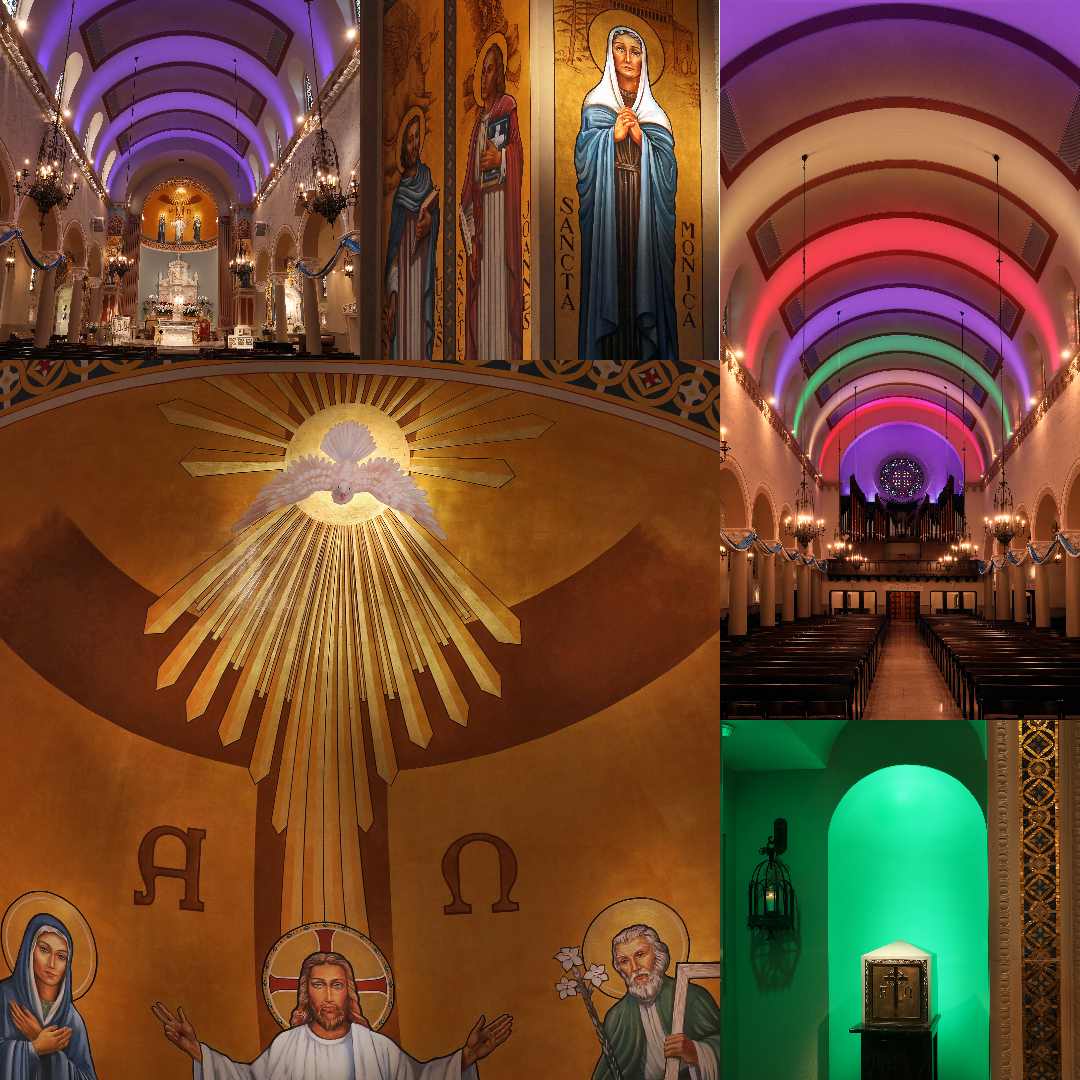
Winter 2017-2018: Plans progressed for the renovation of the church building. The primary focus of the projects included updating the lighting system, painting and a thorough cleaning, necessary as a 21 years of dust, grime, soot, with no significantly upgraded since the reconstruction of the Church after the 1994 Northridge earthquake. Our community moved to the Grand Pavilion and a tent on the Grand Patio for 2 months during the renovation.
In the course of preparing for the renovation, we were referred to several design professionals. We were so grateful that Bridget Williams, a talented lighting designer with a solid reputation in the Southern California region for working with houses of worship, decided to aid is in the project. We were not disappointed. In fact, St. Monica and Bridget Williams Lighting Design were recently recognitzed for achievements in lighting and design.
On Bridget's first visit to St. Monica, within 5 minutes of our meeting and walking into the building, she noted the beautiful frescos in the apse, and said to me: "I’m going to light the Holy Spirit." To remind you, above the head of Jesus, in the apse, is a tremendous image of a dove symbolizing the Holy Spirit descending on Jesus at his baptism.
Bridget has a design philosophy for lighting a building in a way that will highlight the story of the architecture. Working primarily with religious architecture, and a thorough knowledge of the Church’s Liturgy, she has let our gem of a church building shine. Under her careful eye, her design has enhanced focal points of the Litrugy itself: altar, chair, font, ambo, assembly. Each element and locus has been thoroughly treated with care and attention. She treated our building with so much care, the same way that it was built and consecrated in 1926, patterned after the Basilica of Santa Sabina on the Aventine Hill in Rome. The video at left depicts the Basilica and it's beautiful configuration: "The architect was particularly aware of the light effects in an interior space like this. The glass tiles of the mosaics would create a shimmering effect and the walls would appear to float. Light would have been understood as a symbol of divinity. Light was a symbol for Christ. The emphasis in this architecture is on the spiritual effect and not the physical. The opulent effect of the interior of the original Constantinian basilicas is brought out in a Spanish pilgrim’s description of the Church of the Holy Sepulcher in Jerusalem." (Dr. Allen Farber, "Basilica of Santa Sabina, Rome," in Smarthistory, August 8, 2015, accessed August 14, 2020, https://smarthistory.org/santa-sabina/.)
Dale Sieverding, our Director of Worship, recently spoke with Bridget to ask where she gained this understanding and how she developed her philosophy of lighting design. She immediately spoke of the way she was raised with love and care in her family, and the influence of her godmother, who helped her with catechism and taught her about faith, church, worship. Raised in a variety of churches, she was baptized as a child at the San Gabriel Mission, and which she is now on the project team for it's reconstruction after a recent devastating fire. She said that Catholicism, planted in her as an infant, keeps drawing her back, even though her growing up, that deep connection has stayed with her throughout her life.

Dale was compelled to ask Bridget why she had said that, upon first seeing the space: "I’m going to light the Holy Spirit." She responded that, when visiting St. Peter’s basilica in Rome, designed in the renaissance, she came upon the stained glass window of the Holy Spirit in the apse – beyond Bernini’s baldachino over the confessio, to which she was immediately drawn. “I had to light the Holy Spirit, because the Spirit is responsible for everything." It is the Spirit that hovered over the waters of creation, brought about life, descended on Christ at his baptism, was sent as counselor, guide and advocate to give birth to the church after the resurrection.
Bridget's work has reached critical acclaim: Bridget Williams Lighting Design recently won an award from the Illumination Engineering Society for their work on the St. Monica Lighting Renovation project. The project included a very talented team of architectural, electrical and general contractor groups that seamlessly integrate lights and supportive equipment. The lighting controls were designed to run on time-schedules, and can be adjusted to transform the interiors when required. Many of our regular visitors will note that the lighting often reflects the liturgical season; at our highest attendance Masses, such as during the Christmas and Easter seasons, the interior of the Church is enhanced by the innovative lighting design, making it a prayerful and beautiful space for worship and represents the heart of our community.
We congratulate Bridget and her team - thank you for the great work for the benefit of our community. To learn more about Bridget, and see other projects she has worked on, visit: www.Bridgetwilliams.com.
The awards ceremony can be viewed at https://www.youtube.com/watch?v=9-8-OSUdt3w - with Bridget's award for her work at St. Monica at the 17:35 minute mark.
Below are images of the completed project:

- Home
- About
- About Welcome
- Our Community
- Our Campus
- About Buttons
- Sacraments
- Worship
- Ministries
- Ministries Welcome
- Faith Formation
- Fellowship Groups
- Pastoral Care
- Events
- Media
- Serve
- Serve Welcome
- At St. Monica
- Locally
- Africa
- Give
Announcements
- Film Club: Lessons from Hotel Rwanda
- Month of Remembrance
- ⭐ The Relic of Saint Carlo Acutis Is Coming!
- Stewardship Renewal 2025: Make Your Pledge Today!
- ⭐ Feast of Saint Monica this Weekend!
- Meet Dr. Erin Luby, Saint Monica Preparatory's New President
- Thu May 22, 7p: Notre Dame Folk Choir
- Monsignor Welcomes Pope LEO XIV
- Mother's Day Novena 2025
- Happy 60th Anniversary, Monsignor!
- Pope Francis (1936–2025): Remembered by Msgr. Torgerson
- EASTER 2025 at St. Monica
- Saint Monica Academic & Spiritual Heritage: Rooted in Family
- SAVE THE DATE: Rooted in Family Gala & Auction 5/10
- ⛪ Parish Mission Retreat: 3/10-3/12
- ? Second Annual Ethical Leadership Lunch
- ? Catholic Schools Week: Jan. 26–Feb. 1
- Palisades Fire Update, Jan. 11
- Hospitality for Palisades Fire Evacuees
- A Christmas Message from Msgr. Torgerson
- Christmas at St. Monica 2024
- Dale Sieverding, SLD (1963–2024)
- ? Why We Sing
- Msgr. Statement: Settlement 2024
- Behind the Scenes at St. Monica
- ?️ Prayer Service for Peace: Oct 7
- Share Your Birthday Wishes for Msgr. Torgerson's 85th Birthday!
- Volunteers of the Year 2024
- Letter from Deacon Kevin McCardle
- An Update from Msgr. Torgerson: June 21, 2024
- Msgr. Torgerson Health Update: June 17, 2024
- ? MEDIA AS A GIFT OF MINISTRY Event!
- ? Estate Planning Seminar | May 13
- Communion Under Both Species
- ? Race 4 Veronika's Place at the LA Marathon
- ⛅ Sacred Air: The JustFaith Team Visits Wilmington
- ? Congratulations, Donna!
- ? Reaching for Heaven
- ?♥ Valentine's Pet Hike
- First5 January Social ??
- Navigators Ministry Launches!!
- Navigators Ministry at St. Monica
- Resounding Resilience: The 30th Anniversary of the Northridge Earthquake
- It’s a Hand Up, Not a Hand Out: St. Monica Habitat for Humanity
- St. Monica Blood Drive
- Farewell Sister Edith!
- Christmas at St. Monica 2024
- Haunt Couture: GLO Halloween Party
- Month of Remembrance
- Bishop Elshoff Welcome Mass
- Praying for Peace
- Blessing of the Animals 2023
- GLO Fall Kickoff 2023
- Homeboy 5K 2023
- Catechetical Sunday
- St. Phoebe Day 2023
- St. Monica Serves: In Deed and In Truth
- Layer Up Interfaith Clothing Drive
- Homeboy Industries 5K: Sept. 23
- Prayer for Good Humor by St. Thomas More
- "Don't Inform → INSPIRE!"
- St. Monica Order of Malta: Lourdes Pilgrimage 2023
- Saint Monica Preparatory
- My Calling
- Msgr. Torgerson and HCAM return to Africa!
- Team "Race 4 Veronika’s Place" crosses the finish line!
- Happy 57th Anniversary of Ordination, Msgr. Torgerson!
- Peace in Ukraine
- Msgr. Torgerson: Church Burglary
- Listening to Us All: Pope's Synod Coming to St. Monica
- CRS Rice Bowl
- Mother's Day Novena
- Father's Day Novena
- People Want a Lenten Reflection from YOU!
- Christine Gerety and St. Monica featured in Angelus News!
- Fr. David John Ayotte, 1960–2021
- Young People are the Future of Kenya - Let's Support Them!
- Anniversary of Ordination Celebration: Fr. Willy
- Fr. David Ayotte Health Update: Nov. 3
- An Evening with Patrick Saint-Jean, SJ, Psy.D
- Who is Santa Claus…for real?
- Mass and Music Survey
- Active Duty Prayer Board
- Holy Land Reflections 2022
- Each was a hard act to follow
- Honoring Martin Luther King Jr.
- Uniting Our Hearts And Minds: A Message from Msgr. Torgerson
- Rethinking Mother's Day with the Green Team
- Fr. Ron Rolheiser: "The Passion and the Cross"
- Christmas Mass Schedule 2020
- Simbang Gabi Message from Bishop Alex Aclan
- At Home With Our Mangers
- Living With Grief During The Holidays
- Special Delivery: Holiday Greetings
- Saturday, Dec. 19: Advent Communal Reconciliation Service
- Sunday, Dec. 13: Festival of Lessons & Carols
- Support the Youth of Our Sister Parish in Kenya
- A New Way to Bible Study: Scripture Encounter Saturday Series
- Solemnity of the Immaculate Conception & Feast Day of Our Lady of Guadalupe
- November: Month of Remembrance
- Awaiting in Joyful Hope: Advent Small Groups
- Election Day: Candlelight Novena for National Peace and Unity
- Oasis Women's Retreat
- Calling all MOMS!
- Catholic Charities Gala Honors Parishioners of St. Monica
- Daylight Savings Time: Mass Schedule Updates
- Prepare the Way with Scripture Encounter Part 2
- Updated: Women of St. Monica, Saint Monica Feast Day
- Catechetical Sunday: Sep. 20
- 2020 World Day of Migrants and Refugees
- April is Child Abuse Prevention Month
- Aug. 27: Feast Day of Saint Monica
- A Story of Light: St. Monica 2018 Renovation Wins Award
- Like Pope Francis, We are all Sinners: Scripture Encounter begins Aug. 24
- Feast of St. Ignatius of Loyola: Holy Hour
- Volunteer Appreciation
- COVID Update (7/16): Outdoor Masses
- Welcome Fr. Dave Ayotte!
- Congratulations Class of 2020!
- COVID Update (7/13): Indoor Restrictions
- Fr. Ian's Farewell Parade
- Holy Grounds is Open
- All Parishes Remain Closed (May 23–24)
- Our Response is Love.
- COVID-19 Update from Archbishop Gomez (May 15)
- Solemnity of Mary, The Mother of God & World Day of Prayer for Peace
- Happy 56th Anniversary, Monsignor!
- May 1: Consecration to the Blessed Virgin Mary
- A Christian Prayer in Union with Creation
- St. Monica Affiliated Restaurants & Businesses
- Pope Grants Extraordinary Blessing
- #SingWhereYouAre
- ADLA Suspends Masses (3/16)
- Coronavirus (3/13/20)
- Coronavirus (3/12/20)
- Are you a Catholic Creative?
- More than a Marathon: Race 4 Veronika's Place
- Oscars...anyone?
- New Year's Day: Solemnity of Mary
- Msgr. Torgerson in Good Condition, Despite Fall
- New Support for Youth Initiatives at our Sister Parish Holy Cross Dandora, Kenya
- 40th Annual Thanksgiving Dinner & Boutique
- Tolton Tickets on Sale
- The Film Club kicks off by looking back
- Fr. Bob Dowd Visits St. Monica
- David Hines: Volunteers of the Year 2019
- And there wasn’t a life jacket in sight...
- RECongress 2020: "Live Mercy Be Holy"
- Sister Rose Took Us to the Movies
- Stations of the Cross & Soup Supper
- And the winner is…
- Together in Mission 2019: Our Story is Hope
- Dancing With Our Stars 2019
- Laurel and Hardy took top billing
- The Evening Was Merry and Bright
- Holy Cross Africa Ministry (HCAM) Education Fund
- Christmas Mass Schedule 2018
- Hospitality for Woolsey Fire Evacuees
- To the sky and back...
- In Gratitude
- Living in Gratitude: Stories from our parish family
- SCAM ALERT: Email Posing as Msgr. Torgerson
- Popcorn and kisses…what else?
- St. John's Seminary Annual Gala
- Hurricane Florence Fund Collection
- Pastoral Statement RE: Grand Jury Report
- Mission Co-op Appeal 2018
- David Hines "Volunteers of the Year"
- YMA Delivers Sweet Treats
- The Parish Survey Results Are In!
- The Good Friday Journey
- RE Congress 2018: "Rise Up!"
- Lenten Fish Fry Kicks Off Friday Stations!
- Together in Mission 2018
- Sutherland Springs, TX
- Art of Living Meditation Course: Oct. 20–23
- Pastoral Statement: Las Vegas Shooting
- St. Monica Stands with DACA Youth
- Hurricane Harvey Flood Relief
- Hear and practice the new 7:30 Mass parts!
- Habitat Casino Night: Aug. 19
- Living in Gratitude: Parishioner Stories
- Rel Ed Congress "Embrace Trust"
- Valentine's Day Shopping
- Natural Disaster Relief
- The Samaritan Woman: Tri-Parish Spring Workshop
- Register Now for Faith Odyssey 2017
- Architects of Change LIVE | with Maria Shriver
- SoCal Wildfires Response & Resources
- St. Monica University - Advent Small Group Faith-Sharing
- Support St. Monica by donating a used vehicle!

Mass
Mon–Fri, 7:00 am - Church
Mon–Fri, 12:10 pm - Church & Livestream
Sat, 8:00 am - Church & Livestream
Sat, 5:30 pm - Church
Sun, 7:30 am - Church
Sun, 9:30 am - Church & Livestream
Sun, 11:30 am - Church
Sun, 5:30 pm - Church & Livestream
Outdoor seating is available at all weekend Masses.
Confession
Mon–Fri. 5:30–6 pm
Sat, 4:30–5:00 pm
There are no confessions on secular holidays or other observances when the parish is closed.
Holy Days & Holidays
Holy Days: additional Vigil and evening Masses, 6:30 p.m.
Holidays: single Mass, 9:30 am with no confessions
Eucharistic Adoration
First & Third Fridays: 7:30–8:30 a.m. & 7–8 p.m. · Church
Second & Fourth Sundays: Noon–3 p.m. · Chapel
contact us
St. Monica Catholic Community
725 California Avenue
Santa Monica, CA 90403
310-566-1500 Contact Us



